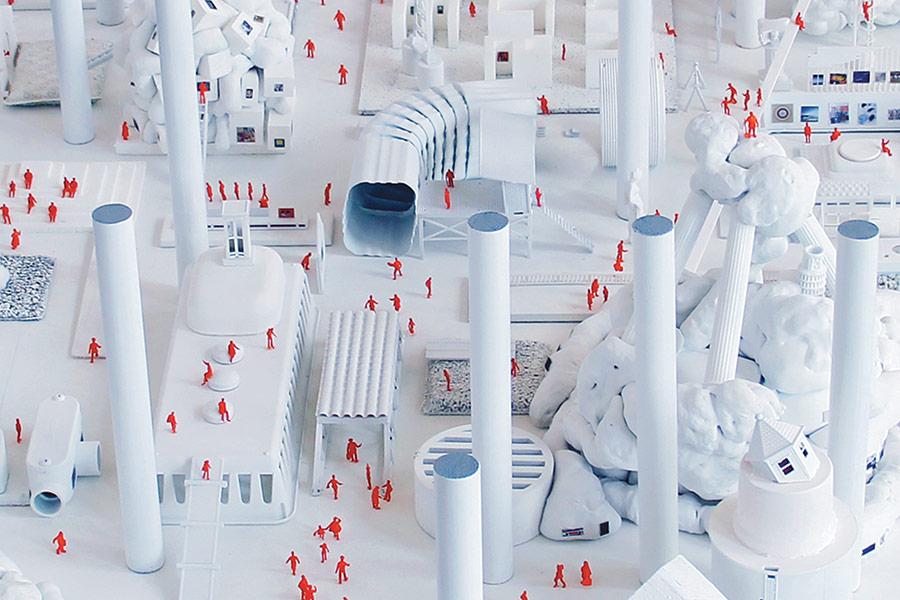
Treatise: Why Write Alone?
Jimenez Lai
Graham Foundation
Through March 28
When I met Jimenez Lai at the Graham Foundation in Chicago, he was literally putting the finishing touches on his new show, Treatise: Why Write Alone? The 35-year-old head of Bureau Spectacular was perched on a ladder, adding a few more strokes to his stream-of-consciousness tableau of cartoons that covers an entire wall of the gallery at 4 West Burton Place. Climbing down, he explained the show’s origins.
The show draws most directly on the “Pamphlet Architecture” series Steven Holl and William Stout started in the 1970s. “They had their expression of youth,” said Lai, “and maybe this is ours.” He called it “an ice-core sample” of emerging and nonconformist designers.
Rather than roll out their treatises over many years, Lai and his colleagues published all at once. The result is a bright and unusual show more playful than provocative, but a strong statement nonetheless—since ancient Italian architects broke from building (fabris) to explore reason (ratio), architects have always been more than factories for functional built work. Subtitled, Why Write Alone?, Lai’s show is “a Tarzan call into the forest of bad attitudes” yielding 14 individual responses, “where the selfish pursuit of writing amasses to form a collection.”
|
Point Supreme’s Faliro Pier, 2012 (left) and Kotzia Square, 2013 (right).
Courtesy Graham Foundation
|
||
The contents of that collection are as varied as its participants, which hail from the expected hubs of New York, Los Angeles, and Chicago, but also as far as Belgium and Greece. Participants include: Bittertang, Lai’s own Bureau Spectacular, CAMES/gibson, Design With Company, FAKE Industries, First Office, Pieterjan Ginckels, is-office, Andrew Kovacs, Alex Maymind, Norman Kelley, Point Supreme Architects, SOFTlab, and Young & Ayata. The treatises themselves will be available in March, according to the Pentagram-designed pamphlet that accompanies the show.
Some are subtle smirks, like First Office’s white-on-white wall paintings and useless light switches that turn the building itself into a “really weird riddle,” according to Lai. That kind of deadpan humor infuses some of the work of Norman Kelley—Carrie Norman and Thomas Kelley—who offer a series of defective furniture. Each piece in their collection is somehow wrong, but it’s wrong with panache. The question (beyond “should I sit in this?”) seems to be, “Is this defective, or daringly designed? Is it over- or under-designed?”
Such questions come and go as one tours the two-floor exhibition. Lai’s own wall-drawings, a mishmash of “recurring dreams” that he considers “cave paintings,” are a pleasant chaos. Cartoon characters converse in a geometric language, floating on a sea of architectural memes—Le Corbusier’s Villa Savoye, Frank Gehry-esque pavilions, and even the agglomerated wooden orbs of SOFTlab, which hover a few feet from the wall, pop up in the black-and-white painting.
Other installations tickle a more emotional layer of consciousness. Brussels-based Pieterjan Ginckels turns a second-floor room into a fog-filled theater for immersive video work that he called “low-tech, rendered opera.” Dirge-like electronica scores a psychedelic first-person ride through strange and familiar places under a lime green sky. Andrew Kovacs’ work is that of “an intellectual hoarder,” said Lai, collecting forms and unfinished architectural solutions in his “Guggenheim Helsinki Model,” which is overrun with little orange visitors. Bittertang’s hanging Piñata marries inviting surfaces and bright colors with smears of earwax and disconcerting organic forms, encapsulating both the wonder and repulsion with which we approach nature.
|
Design with Company (Stewart Hicks & Allison Newmeyer), Midwest Culture Sampler, 2015 (left). is-office (Kyle Reynolds & Jeff Mikolajewski), Javits, Javits, 2012 (right).
Courtesy Graham Foundation
|
||
While the playful collection is very much of its time, historical references and allusions to precedent abound. Alex Maymind’s 100 Drawings ruminate on grids, layers, and their intersections with other basic forms, recalling Peter Eisenman’s analytical drawings and postmodern projections. The Chicago-based collective Design With Company warps Frank Lloyd Wright’s Broadacre City development concept with a surreal model of Midwestern farms interrupted by palatial architecture and kitschy “world’s largest” totems.
How exactly the work displayed in the Treatise show exemplifies the manifestos of its 14 inventive contributors might only be clear upon the publication of their written work in March. Even without that context, the show engages on many levels, provoking questions, second looks, and subconscious explorations that seem to answer Lai’s subtitle—why write alone? It produces new work, unburdened by others’ expectations. Why write together? No solitary designer could dream up the wild collection of work displayed here, much less the strange and sometimes wonderful relationships that result between them.